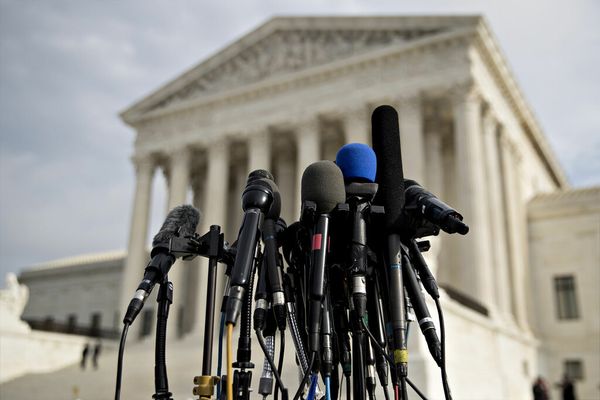
You don’t have to look hard to see how American democracy is ailing. In just one week this summer, a man who may have participated in the January 6 insurrection was shot after attacking an FBI office in Ohio. A Pennsylvania man was arrested for threatening to kill FBI agents. And in Wyoming, Representative Liz Cheney was trounced in a GOP primary after a race that centered on her critique of fellow Republican Donald Trump for trying to steal the 2020 election and inciting violence. Even Trump reportedly worried about a need to “reduce the heat.”
But diagnosing the problem is one thing, and finding a way to deal with it is another. Democracy experts across disciplines, as well as many ordinary Americans, agree about the dangers of hyperpolarization, political violence, and support for antidemocratic candidates. What they don’t have are clear, proven ideas to reduce these forces.
A fascinating, sprawling new study seeks to provide some answers. The news is mixed: The Strengthening Democracy Challenge found many ways to reduce partisan animosity. But intriguingly, it also found that doing so doesn’t necessarily cut into support for antidemocratic candidates or for partisan violence. In short, though partisan animosity has been the subject of intense concern, it may just be the low-hanging fruit for America’s democracy crisis.
Starting from a crowdsourced list of some 250 proposals from across disciplines and outside the academy, researchers from Stanford, MIT, and a handful of other top-tier universities assessed 25 separate tactics, measuring their power to reduce partisan animosity, support for antidemocratic attitudes, and tolerance for political violence. (The researchers tested these out on more than 30,000 participants, a massive sample for a social-science experiment. Rather than try to represent the population as a whole, they focused on people who affiliate with or lean toward the two major parties.) The 25 approaches included ideas as varied as a conversation with a chatbot, watching short videos, and even a meditation exercise. The experiment found promising results in reducing partisan animosity, but less impact on antidemocratic practices and support for violence, and only some correlation among the three.
Consider two of the most effective interventions across the board, which are rooted in the idea that partisans tend to misunderstand their rivals. “There’s robust literature on just how badly we misperceive the views of our rival partisan Democrats and Republicans alike,” explains Robb Willer, a professor of sociology at Stanford and one of the paper’s authors. “People think that their rival partisans have much more antidemocratic attitudes than they actually report.”
In one, researchers showed participants a video about Democrats and Republicans discovering they shared more common ground than they believed. In another, they asked them questions about what the other side believes and then provided the real data on those beliefs, with the hope of demonstrating that the other side is less antidemocratic than either side perceives. Both of these were among the most effective at reducing support for partisan violence and for undemocratic practices, and good at reducing partisan animosity.
But other proposals had less predictable results. In one, researchers showed participants videos about places where democracy had collapsed, such as Turkey, and then presented footage from January 6. The intervention was effective at reducing support for undemocratic practices and partisan animosity—but it actually increased overall support for political violence. (Republicans accounted for the increase, and the researchers speculate that this may be because of the belief among many Republicans that the insurrection was legitimate—an example of how even relatively recent violations of democratic norms are already baked into public perception.)
One of the most important takeaways from the SDC might be the ways in which the results for the three goals diverge. For some time, scholars and journalists, including me, have focused on partisan animosity—sometimes describing it as “affective” or “negative polarization,” in which one’s political identity is formed more by despising the other side than by any particular affinity for the views of one’s own party. (Think “owning the libs.”) After all, the increase in partisan animosity coincides with some of the more disturbing trends in American politics, and it seems intuitive that hating the other party would be connected to support for political violence and other undemocratic practices.
But this project found that partisan animosity seemed to have little relation to antidemocratic attitudes, and interventions that reduced animosity didn’t always do much to reduce those antidemocratic views. For example, one approach, which focused on how press coverage drives polarization, had strong results in reducing partisan animosity, but was among the least effective at the other two metrics. The split is troubling for a couple of reasons: First, it may mean that a lot of the existing research has been directed toward producing less essential change. Second, and worse, it suggests that there may be a latent reservoir of antidemocratic attitudes that predated today’s negative polarization.
“We probably have overfocused on partisan animosity and haven’t looked as closely at democratic attitudes and support for partisan violence as we should,” Willer said. “If you improve people’s partisan animosity, you don’t necessarily change their commitment to democratic principles.”
Those attitudes also seem to be spread throughout both parties. In the study’s sample, Democrats are roughly as supportive of political violence as Republicans, and less tolerant of antidemocratic actions, though only marginally. This is at odds with what is visible in politics in practice: The de facto leader of the Republican Party, Donald Trump, has been a strident proponent of antidemocratic principles, fighting voting access, trying to overturn the 2020 election, and inciting a mob to attack the Capitol on January 6. Many other GOP officials have followed his lead, and these elite cues explain both the higher Republican tolerance for antidemocratic concepts and their manifestation. Nevertheless, the danger remains that a Democratic demagogue could sense an upside in preying on the same instincts on the left side of the aisle.
To see the challenge facing the country, look no further than the growing popularity among Republicans of the spurious argument that the U.S. is “a republic and not a democracy.” Scholars who want to strengthen the American system of government will need to continue to identify effective ways to fight these strains of thought.










